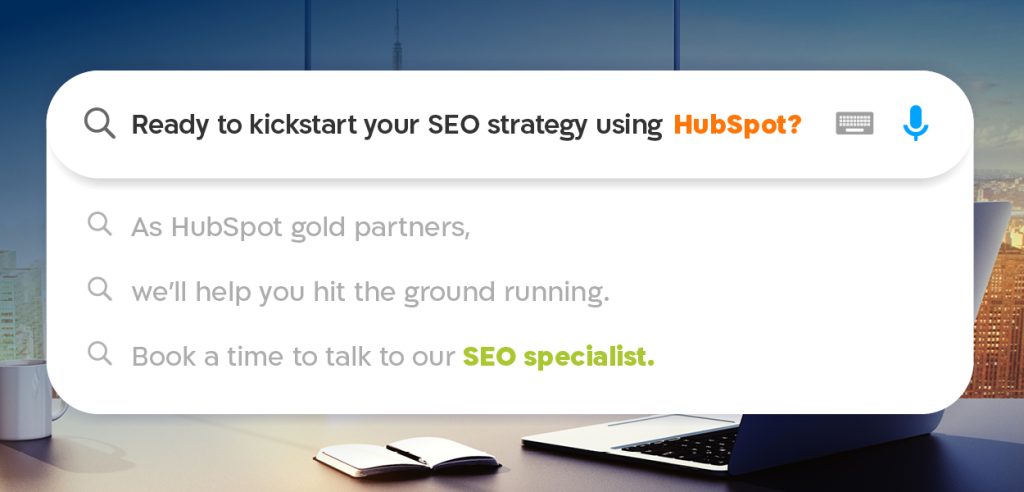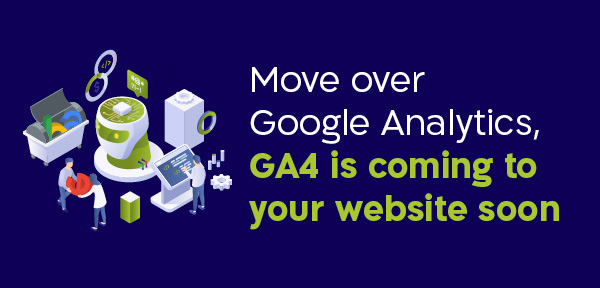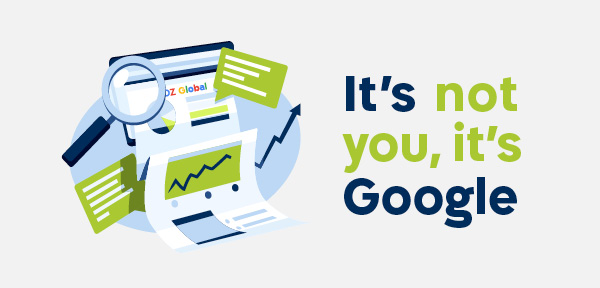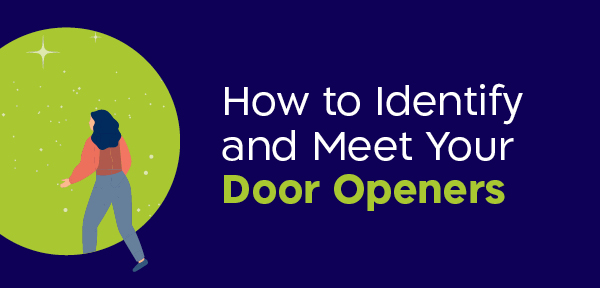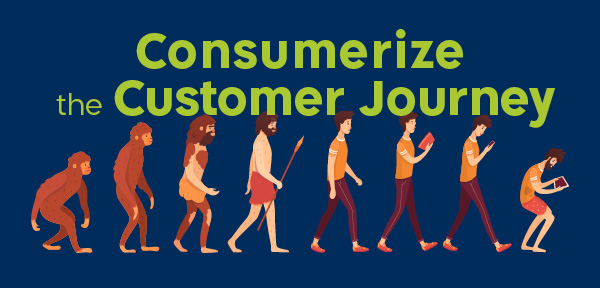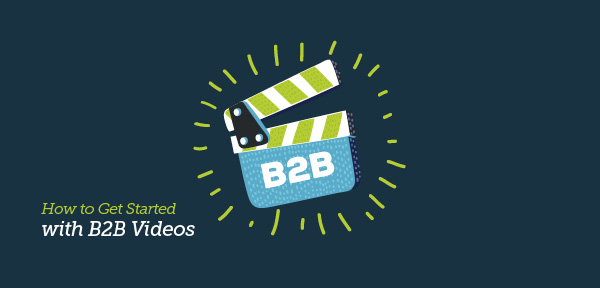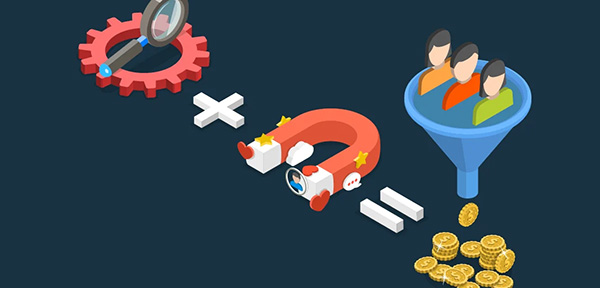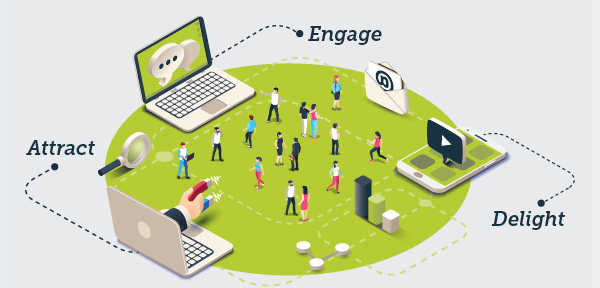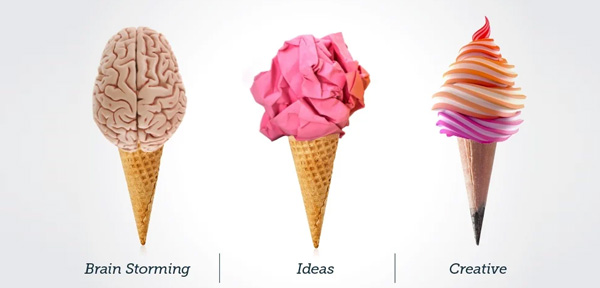The BL[OZ]
Unlock SEO Automated Success: Top 7 SEO Strategies You Can Automate with Make (Integromat)
By
Orly Gilad
, 07/03/2024
Are you overwhelmed by the relentless pace of digital marketing and the constant need for SEO optimization? Imagine if you could put some of those tasks on autopilot. That's where Make (formerly Integromat) comes into play, offering a way to supercharge your SEO strategies with automation. Let's delve into seven automation strategies that can not only save you precious time but also improve your website's standing in search engine results.
1. Competitor Analysis Automation
Imagine having a secret window into your competitors' strategies, giving you the upper hand. By automating the tracking of their blog updates, keyword usage, and SEO maneuvers, you're essentially doing just that. It's like playing a strategic game where you're always one move ahead, nimbly navigating through the ever-changing landscape of digital competition. For Example: Automatically tracking a competitor’s blog updates and keyword changes.How-to:
- Set Up Triggers: Use RSS feeds or webhooks to monitor competitor blogs or websites.
- Extract Key Data: Use Make scenarios to automatically extract new content details such as titles, keywords, and descriptions.
- Analyze Changes: Use SEO tools like SEMrush or Ahrefs to analyze any new keywords or strategies they're employing.
- Send Reports: Configure Make to send periodic reports with this data to your email or Slack.
2. Streamlined Local SEO Management
Streamlining your local SEO tasks, like keeping Google My Business listings up to date and monitoring reviews, can make a big difference in how you rank locally. Automation takes the heavy lifting out of the equation, making sure your local presence is both accurate and compelling without constant manual oversight. For Example: Updating and monitoring Google My Business listings for multiple locations.How-to:
- Connect to Local SEO Tools: Integrate with tools like Moz Local or Yext.
- Automate Updates: Set up processes to automatically update listings with new hours, photos, or responses to reviews.
- Monitor Reviews: Get alerts for new reviews to respond quickly.
- Reporting: Generate regular reports on listing performance and local search rankings.
3. Image Optimization on Auto-Pilot
Automating the optimization of images on your website can significantly boost page performance. Faster loading times not only enhance the user experience—a key SEO factor—but also free up your time to focus on other aspects of your website. For example: Automatically optimizing images uploaded to your CMS. What can I do?- Monitor New Uploads: Set up a trigger for when new images are uploaded to your CMS.
- Connect to an Image Optimization Tool: Use services like TinyPNG or Kraken.io within Make.
- Optimize and Replace: Automatically optimize the images and replace the originals with the optimized versions on your site.
4. Efficient Content Research - Capitalize on Trending Topics
Automating your content research can keep you ahead of the curve. By pulling in trending topics from social media and news outlets, you can craft content that truly speaks to your audience and attracts more visitors, all while saving time on manual research. For Example: Gathering trending topics from social media and news feeds. What can I do?- Set Up Social Media Triggers: Monitor keywords and hashtags on platforms like Twitter or Reddit.
- Integrate with News Aggregators: Use tools like Feedly to pull in trending topics.
- Collect and Analyze Data: Aggregate this data for analysis to identify popular subjects.
- Generate Content Ideas: Use this data to inform your content creation strategy.
5. Automated SERP Analysis - Monitor Your Keyword Success
Automated SERP analysis allows you to monitor your keyword rankings effortlessly. This ongoing oversight offers crucial insights, enabling you to tweak and enhance your SEO strategies for better results, without the need for constant manual checks. For Example - Monitoring search engine result pages for selected keywords.What can I do?
- Use SEO Tools: Integrate with tools like Moz or Ahrefs.
- Set Keyword Triggers: Monitor specific keywords and get updates on their SERP rankings.
- Analyze Data: Collect data on rankings, featured snippets, and other SERP features.
- Adjust Your Strategy: Use these insights to refine your SEO strategy.
6. Proactive Broken Link Management - Maintain a Healthy Website
By automatically detecting and fixing broken links, you're ensuring your website remains navigable and SEO-friendly. This kind of proactive management keeps your site in top shape, enhancing both the user experience, and your SEO profile with minimal effort on your part. For Example: Regularly scanning your website for broken links.What can I do?
- Schedule Regular Scans: Use tools like Screaming Frog or Broken Link Checker.
- Integrate with Your Website: Connect these tools to your CMS.
- Automate Notifications: Set up alerts for when broken links are found.
- Quick Repair: Use these alerts to promptly fix or replace broken links.
7. Social Media Engagement Tracking - Understand Your Audience Better
Automatically tracking your social media engagement gives you a clearer picture of what resonates with your audience. This insight allows you to adjust your content and SEO strategies to better align with audience preferences, streamlining your efforts for more effective engagement. Example: Analyzing engagement on your social media posts.How-to:
- Connect to Social Platforms: Integrate with platforms like Facebook, Twitter, LinkedIn.
- Gather Engagement Data: Collect likes, shares, comments, and other engagement metrics.
- Analyze Trends: Use this data to understand what content resonates with your audience.
- Report and Refine: Generate reports for your team to review and refine your social media strategy.
Will AI Replace Designers or Serve as Their Creative Allies?
By
Yoav Sondak
, 21/02/2024
Will AI replace designers, or will it become their indispensable assistant? Can anyone become a designer with AI's help? Discover Yoav's insights after extensive experimentation with AI tools, and learn what AI itself has to say about the matter
- Automated image editing features — analyzes images to intelligently suggest enhancements and automatically makes adjustments such as color neutralizers and detail enhancers. This speeds up the editing process and is a valuable resource if you’re looking for inspiration or need to make quick refinements.
- Content-aware fill and object removal tools — by understanding the content of the image, it enables you to easily remove unwanted objects or fill in gaps within a scene. This allows greater flexibility and streamlines the editing workflow.
- Accelerates the ideation and iteration phases — lets you explore diverse concepts efficiently.
- Intelligent recommendations — makes suggestions for shapes, layouts, and color schemes based on the context of their project. This makes the conceptualization phase faster and may even help you overcome a creative block.
- Organization and management of design assets — automated tagging and content categorization make asset management easier and help you quickly navigate vast libraries of resources. It’s able to analyze vast datasets and identify patterns that we might miss.
- Rapid prototyping — enables quick experimentation with lots of variations.
Traditional graphic tools have also made huge strides
In recent years, existing software and applications we’ve been using for years have incorporated a variety of tools that shorten processes and streamline design work. Because designers can give online feedback, the tools' capabilities keep getting better. During image processing, design tools can complete missing details, increase resolution, carry out color corrections, and produce more controlled and accurate results. There are also lots of options for image manipulations and variations. These advances have meant that the time between planning and the finished product is much shorter, and have saved me and many others from a tiring technical struggle with traditional design tools. However, AI has added new superpowers which can create impressive artwork at warp speed.
If AI can do all that, why do we need humans?
While AI provides a broad range of design options and there is a wealth of tools to choose from, the act of selection and focus during the design process has become more challenging. The need to differentiate the customer’s brand, memorably present their messages, and tell their unique story means that every designer needs a clear understanding of what they want to create using the tools. Formulating the design prompt and selecting results, when every result seems to be ‘beautiful and impressive’, means that designers need to carefully examine what is ‘right and appropriate’ — and ask themselves what will yield the desired results. It’s the same question that we’ve been asking for years when approaching a design task, long before AI tools entered our lives.The human touch
“While AI excels at generating designs based on existing patterns, it lacks the intrinsic understanding of cultural nuances, emotional subtleties, and context that human designers bring to the table,” responds ChatGPT, adding that design is not only about aesthetics but also about storytelling, conveying emotions, and understanding the audience – elements that are deeply embedded in human experience. It goes on to point out that the human mind possesses the ability to empathize, interpret abstract concepts, and infuse designs with cultural relevance. Designers are adept at translating complex ideas into visual narratives that resonate with people on a profound level. “The intangible aspects of creativity, intuition, and emotional intelligence are quintessentially human and crucial to the design process,” it notes.
Don’t fire your designers!
Bearing these unique human attributes in mind, ChatGPT’s conclusion is almost inevitable: While AI image generators are valuable tools, amplifying designers’ creative capacities and streamlining workflows, they are best seen as collaborators rather than replacements. The future of design lies in a harmonious collaboration between human designers and AI, where each contributes its strengths. While AI enhances the design process by offering efficiency and inspiration, according to ChatGPT, “the unique qualities of human creativity, ingenuity, and understanding will continue to be an indispensable force in the world of design.” As with any AI application, there are ethical considerations. Designers must “be mindful of potential biases in AI algorithms and exercise discretion in their application. Striking a balance between automation and human intuition remains crucial to preserving the authenticity and creative vision of the designer.” ChatGPT predicts that “As technology continues to advance, the symbiotic relationship between AI and design is poised to reshape the industry, unlocking new realms of creative possibilities.” On a personal level, I use AI design tools daily to carry out various tasks and to fuel my creative process. I also find that ChatGPT is useful in helping to formulate prompts and finding the right wording for the industry or application. The more accurate the prompt, the better the results. However, personal experience has shown AI can’t replace the invaluable interactions between our design team and our clients. We’re able to dig deep into their story and translate that into unique and powerful visuals that communicate their brand promise. It’s the ‘secret sauce’ that makes the difference. In short, AI will become our creative allies, but they’re not going to replace us any time soon.Why HubSpot and ABM go together like hummus and pita?
By
Liron Ramot
, 22/01/2024
Discover the powerful synergy between HubSpot's Inbound Marketing and Account-Based Marketing (ABM) in our blog. Inbound sets the foundation for a robust ABM approach, attracting a broader range of prospects. Learn how HubSpot's ABM tools facilitate quick strategy setup, collaboration, attraction of high-value accounts, and effective tracking.
Inbound Marketing
Attracts customers by creating valuable content and experiences tailored to them. It’s about building meaningful relationships with consumers, prospects, and customers.Account-Based Marketing
A B2B strategy in which marketing and sales work together to create personalized buying experiences for a select set of high value companies.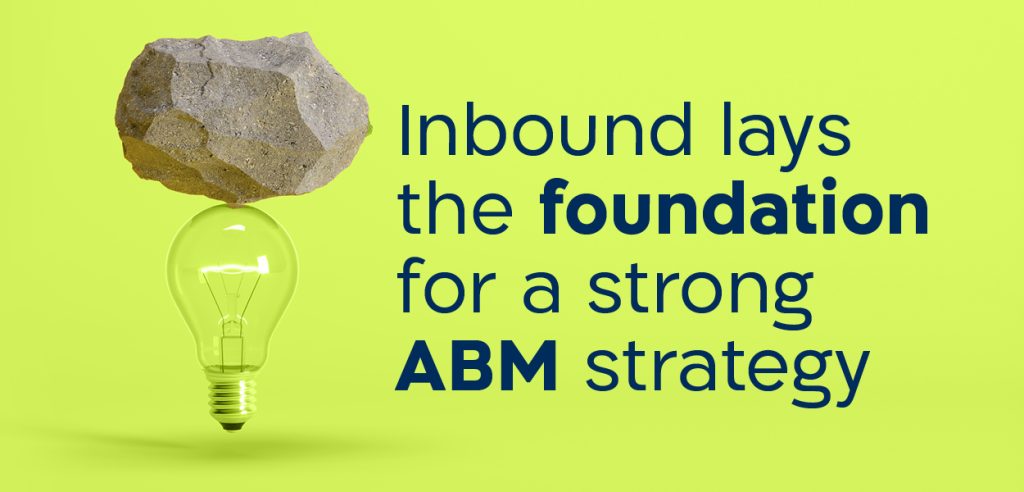
Inbound lays the foundation for a strong ABM strategy
According to HubSpot, inbound marketing helps you attract contacts associated with your target accounts. ABM accelerates the flywheel (the cyclical marketing funnel comprising attract, engage, and delight) so you can win and delight your target accounts by providing a standout customer experience. By using inbound, you’re able to carry out highly-targeted allocation of the most relevant resources to your high-value accounts. As a B2B marketer, by using this combined approach you can attract a broader group of prospects than you would if you were only using one method.Double up and deliver value
Your carefully crafted content has a two-for-one value. You can create and use content that serves both your ABM and inbound strategy. As an example, once you’ve created a personalized case study for a target account, you can also share on your website.Leverage account-based marketing tools
HubSpot’s ABM tool makes it easy to implement ABM and inbound strategies in a complementary way. Its CRM platform connects all of your sales and marketing data and allows enables customer-centric automation and personalization. It makes it easy to use data to segment and target your accounts and marketing automation to nurture your buyers or buying committee and hand over your leads to sales. 1. Set up ABM strategy quickly and smoothly
1. Set up ABM strategy quickly and smoothly
- Use workflow templates to define your ideal customer profiles and identify good-fit target accounts
- Set up default properties to tag accounts and buying roles
- Leverage AI-powered recommendations of target accounts
- Use shared tools that unite your teams around the same data in the same place
- Use the Target Accounts feature to obtain a bird’s eye view of progress across all target accounts
- Use Slack to support high-value target accounts, post KPIs, and share notes
- Personalize content and tailor how you engage with stakeholders within an account
- Use account-level targeting in LinkedIn Ads integration to target companies by account status or tier
- Deepen your relationships over time & build connections with stakeholders within each account
- Use the account overview feature to understand what’s happening at an account level
- Employ out-of-the-box ABM reporting dashboards to get a higher-level view
- Obtain a higher level view using company scoring to identify the highest value accounts and prioritize reachout
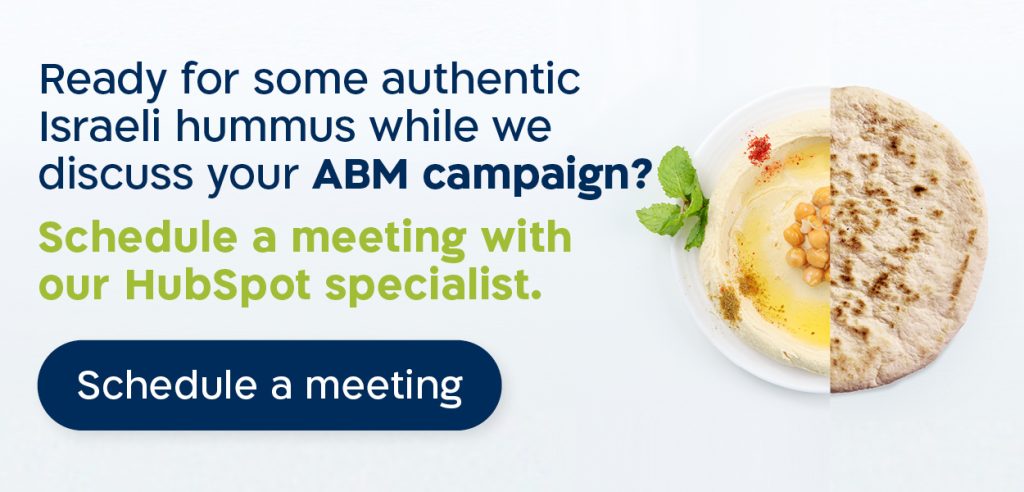
Spice up your SEO strategy with HubSpot
By
Liron Ramot
, 12/12/2023
Optimizing your website for search engines is crucial. Explore how HubSpot’s SEO Marketing Software simplifies the process. From SEO recommendations to content strategy creation and seamless integration, HubSpot streamlines your SEO efforts. Leverage its tools to define target audiences, research topics, and organize keywords.

How is your website ranked?
Google’s algorithm changes daily, but as a general rule of thumb, it ranks your website on three main factors: on-page SEO, off-page SEO, and technical SEO.- On-page SEO — covers three key areas:
- High-quality content (the heart of on-page SEO)
- HTML (source code including page titles, headers, meta descriptions, image alt-text, and more),
- and site architecture elements (such as page URLs, internal linking, and more).
- Off-page SEO — social sharing, external linking, and more.
- Technical SEO — structured data, site, speed and mobile readiness.
Don’t procrastinate, automate!
Why waste time, money and manual work when HubSpot SEO Marketing Software does it all for you? It can help you plan your SEO strategy, optimize your content, and measure ROI in three key steps:- Get SEO recommendations to optimize your site- Obtain recommendations ranked in order of priority which show which optimizations will have the biggest impact
- Create an optimized content strategy to build search authority- Obtain topic suggestions based on relevance, competition, and popularity and create high quality content around your core topics
- Integrate your SEO software with HubSpot’s content management tools- Obtain search keyword data, choose canonical URLs, get estimates on which topics will yield organic traffic gains, and track key topics on your dashboard
Get topical!
As the SEO project leader, you need to decide on each page’s target audience, goal, topic, and target keywords and phrases. HubSpot’s SEO tools make it easy to research and organize topics and subtopic keywords based on your company’s areas of expertise, which serve as the foundation for all the content you create for your website. Creating relevant and up-to-date content helps your website get indexed more accurately by search engines such as Google, which analyze keyword phrases in your content, title, meta description, hyperlinks, and more.Key tips to getting started with SEO
- Crawl your website, conduct an SEO audit, and define your site architecture.
- Establish a value proposition for every page and review and edit your content accordingly
- Target your audience for that specific page (if it differs according to market segment, application, or product category)
- Update your URLs, page titles, and meta descriptions.
- Making sure that your keyword/s are included in your URL and are used throughout the page
- Incorporate and optimize relevant visual content
- Add internal and external links
Why use HubSpot for SEO?
If haven’t yet made our case for why HubSpot takes the pain out of SEO and adds the gain, here are a few more good reasons to check it out: You don’t need to be an SEO expert, because its built-in SEO tools are built with marketers in mind. There’s no need to know coding either. HubSpot handles the technicalities, so you can focus on content. Here too, HubSpot has a variety of content planning tools built into the platform. It makes it really easy to connect your marketing assets so you can track the buyer’s journey — from awareness to qualified lead to happy customer.Driving results using Technical SEO Strategy | Case study
By
Orly Gilad
, 04/10/2023
In this in-depth case study, we delve into a real-world SEO project that serves as a testament to the remarkable impact a meticulously planned technical optimization strategy can have on a website's performance.
When the new client, an impressive player in the B2B Medical industry, first approached us, we were fully aware that this was a challenge requiring our utmost dedication. In the following case study, we'll walk you through the five pivotal steps we took to completely revamp their online presence, enhancing both page health and authority in the process - bringing an increase of 25% in traffic in just a few months.
Dive into our latest in-depth SEO case study and learn how Page Health and Authority Optimization can drive real-world results. See the transformative power of a meticulously planned technical SEO strategy.Client Background
Our client, a prominent B2B business, from the medical industry, approached us with a pressing concern: their website's underperformance. The objectives were clear - bolster online visibility, boost organic traffic, and, ultimately, amplify revenue streams. The website presented several challenges, including a distressingly low Page Health score of 48 and a less-than-optimal Page Authority of 17. The Analytics showed a high bounce rate and a low average time on the page.
The mission was unequivocal: transform these pivotal metrics to drive higher organic traffic and conversions by improving its metrics.
Challenges Faced
-
Low Page Health (Score 48): The website grappled with technical and on-page SEO issues that urgently required rectification.
-
Limited Page Authority (Score 17): The website's trustworthiness and credibility fell short, impeding its ascent in search engine rankings.
-
Stagnant Organic Traffic: Organic traffic had plateaued, failing to meet conversion rate expectations.
Strategy and Approach
1. Comprehensive Technical Audit
The first crucial step was an exhaustive technical audit.
This audit unearthed a multitude of issues, including a sluggish page load speed, poor mobile-friendliness, and crawlability impediments.
We also identified and rectified:
-
Broken links, which were harming user experience.
-
Duplicate content issues that led to search engine confusion.
-
Inadequate URL structures that hindered proper indexing.
Furthermore, addressing page speed was of paramount importance. Google's Core Web Vitals update places significant emphasis on page speed, and our efforts in this regard had a profound impact on website health.
2. In-Depth Keyword Research
Simultaneously, we embarked on an extensive keyword research expedition. Our goal was to identify high-impact keywords that resonated with both the client's objectives and current industry trends. This laid the foundation for a robust keyword strategy, ensuring that the content aligned perfectly with the target audience's intent.
3. On-Page Optimization
Optimizing existing content and crafting new, keyword-rich content was the next step. This involved:
-
Enhancing meta tags, crafting compelling headings, and optimizing image alt attributes to enhance visibility.
-
Leveraging schema markup to provide search engines with structured data, enhancing search results' richness.
4. Technical SEO Enhancements
Technical SEO enhancements played a pivotal role in improving website health:
-
We submitted updated sitemaps to search engines for expedited indexing.
-
Canonicalization issues were addressed to prevent duplicate content penalties.
-
An improved website navigation system and internal linking structure provided users with an enhanced experience.
5. Content Marketing and Link Building
The final piece of the puzzle was content marketing and link building:
-
Improving internal linkage between relevant content pieces within the website, which also improved time on site.
-
We created high-quality, shareable content to attract backlinks, thereby elevating Page Authority.
-
Employing ethical link-building strategies solidified the website's authority and trustworthiness.
Results Achieved
1. Page Health Transformation
Within a matter of months, our strategies propelled the Page Health score from 48 to an astounding 95. The resolution of technical issues, especially the optimization of page load speed, resulted in vastly improved overall website performance.
2. Page Authority Ascension
Page Authority, a key indicator of trustworthiness, surged from 17 to a highly commendable 29. The remarkable improvement was primarily attributed to the augmented backlink profile garnered through our content marketing and link-building endeavors.
3. Explosive Organic Traffic Growth
One of the most remarkable outcomes of our SEO campaign was the monumental 20% increase in organic traffic within just three months. Our meticulous efforts in addressing page speed and optimizing for Core Web Vitals played a substantial role in this growth.
4. Enhanced User Experience
By addressing technical issues and optimizing on-page elements, the website now delivers a seamless and engaging user experience. This has led to lower bounce rates and extended user sessions, cementing the site's position in search engine rankings.
Conclusion
This case study serves as a compelling testament to the power of a meticulously crafted SEO plan and precise technical optimization. The transformation of Page Health from 48 to an impressive 95 and Page Authority from 17 to 29 vividly illustrates the tangible benefits of strategic SEO efforts.
By systematically addressing technical issues, optimizing on-page elements, and implementing effective content marketing and link-building strategies, we achieved remarkable results. The client's online visibility, organic traffic, and conversion rates experienced substantial growth. This case study underscores the pivotal role of SEO in enhancing website performance and achieving substantial business growth.
In conclusion, for businesses aspiring to thrive in the digital sphere, investing in SEO is not just a choice; it's an imperative step toward realizing online success.
If you're seeking more detailed information on how optimizing page speed and eliminating duplicate content can enhance your website's health and drive remarkable traffic growth, visit us to read more: https://ozglobalb2b.com/SEO/
Ready to take your website's SEO to the next level? Book a meeting to schedule your consultation and unlock the full potential of your online presence.
How AI Powers Your Marketing & Sales Engine
By
Liron Ramot
, 03/10/2023
Ready to supercharge your inbound marketing game with AI? Say "Aye!" If you're a HubSpot user looking to boost your content creation and sales processes, we've got something exciting for you. Discover how AI can be your secret weapon! Curious to learn more? Click the link to unveil the full potential of HubSpot's AI tools and start revolutionizing your marketing strategy today.
If you’re already using HubSpot to fuel your inbound marketing strategy and drive sales, it’s time you took AI out for a spin
Constantly writing content to fuel your inbound marketing funnel can be time-consuming and costly. While ChatGPT isn’t going to replace your talented content team anytime soon (if at all), it can prove very useful in helping your team conduct research, generate content ideas, and write basic drafts for your team to finetune — so that you can generate more content, faster. It also helps your sales teams focus on closing deals instead of being bogged down by manual tasks. As a HubSpot user, it’s all your fingertips.Say goodbye to writer’s block
Having trouble generating the volume of content you need? Call on HubSpot’s friendly Content Assistant to create or refine web copy, blogs, articles, emails, and more. Using AI, you can generate ideas, outlines, or paragraphs for your required topics. You can also generate sales emails, titles and meta descriptions for pages and posts, and social posts. Simply answer the prompt, “What’s this social post about?” review the result, and tweak until you’re satisfied the post meets your standards. Not writing in English? Set the target language for the required content. Once a language is set, any generated text will automatically be output in that language.Four ways to tweak existing content
Using the “highlight” command, you can rewrite, expand, summarize, or change the tone of the text you’ve highlighted. It’s quick and efficient. Rewrite - Generates different wording for the highlighted text Expand - Elaborates on the content of the highlighted text Summarize - Condenses the highlighted text Change tone - Rewrites the highlighted text in the selected tone: friendly, professional, witty, heartfelt, or educational Beyond using the highlight command, you can also generate headings, paragraphs, and subsections based on your existing content. Clearly describe the content you require and select the required output. Remember to be very specific, use simple language, and provide examples to clarify the context and tone of your request. If at first you don’t succeed, try, try again. Experiment with different prompts until you get the output you need.Best practices for AI-generated content
- Always proofread and edit all your content before you publish it.
- Maintain your brand's voice and style – your tone of voice must be consistent through all marketing materials.
- It’s not all or nothing — remember to balance your AI-generated content with human-generated content.
- Check, check, and check again. While HubSpot has put security measures in place, content assistant may occasionally generate inaccurate, skewed, inappropriate, or misleading information. Make sure you verify the accuracy of the output's content, particularly any statistics or facts.
Streamline your daily sales workflow with ChatSpot.ai
Another great AI tool in the HubSpot toolbox is ChatSpot.ai, which helps your sales team save time and maximizes productivity by carrying numerous daily tasks. It can assist with lead management, adding contacts and companies to HubSpot’s CRM, including specific notes, assigning tasks, and sending reminders as well as personalized follow-up emails – all through simple chat-based commands. It quickly identifies prospects based on specific criteria (such as industry, location, and size) and provides a list of high-potential leads. It’s easy to create real-time custom reports on key metrics, including website visits, lead conversions, and revenue in an easily digestible format. It also aids with forecasting, listing the deals closing within a specific timeframe, the deal stage, as well as anticipated revenues. In short: It simplifies and streamlines your team’s daily workflow, cuts down on time-consuming manual tasks, and helps your sales team do more in less time. All those ready to start using AI, say “Aye!”What is Business to Employee (B2E) and how can it impact your company?
By
Guy Toledano
, 01/10/2023
Business-to-Employee, or B2E, refers to the strategies and technologies that companies use to support and engage their employees. B2E covers everything from attracting, recruiting, training, and onboarding employees, to providing self-service solutions and individualized access to essential tools or software.
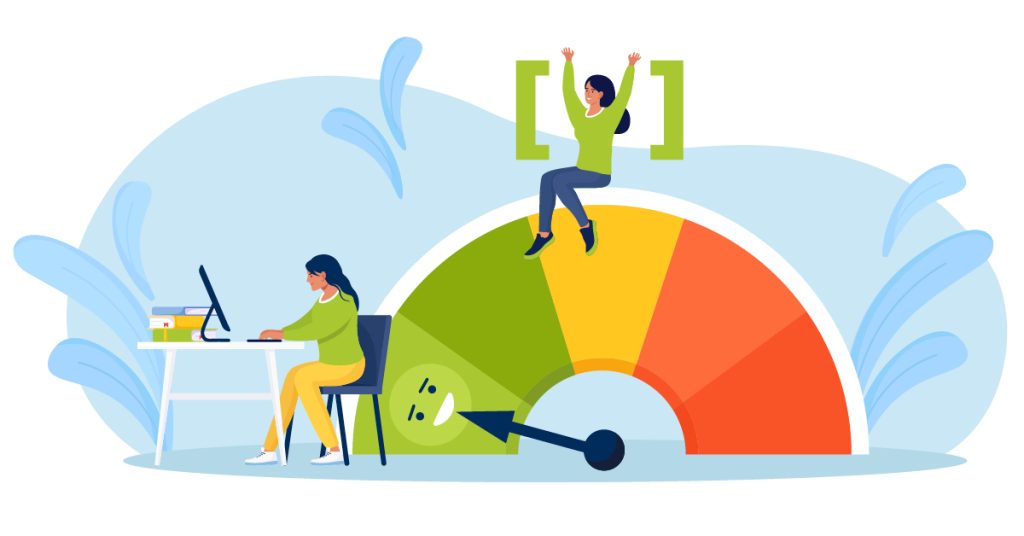 B2E strategies can also be used to support specific departments or teams within a company, such as sales teams that need flexible access to customer information and sales tools. For example, a B2E portal might include a CRM system that allows sales reps to easily access customer data, create and track leads, and manage their sales pipeline.
There are many benefits to implementing a B2E strategy, including improved communication and collaboration, increased efficiency and productivity, and cost savings. By providing employees with the tools and resources they need to succeed, companies can create a more engaged and motivated workforce that is better equipped to meet the challenges of today's business environment.
Have a question? Want to learn more? Don’t hesitate to reach out!
B2E strategies can also be used to support specific departments or teams within a company, such as sales teams that need flexible access to customer information and sales tools. For example, a B2E portal might include a CRM system that allows sales reps to easily access customer data, create and track leads, and manage their sales pipeline.
There are many benefits to implementing a B2E strategy, including improved communication and collaboration, increased efficiency and productivity, and cost savings. By providing employees with the tools and resources they need to succeed, companies can create a more engaged and motivated workforce that is better equipped to meet the challenges of today's business environment.
Have a question? Want to learn more? Don’t hesitate to reach out!

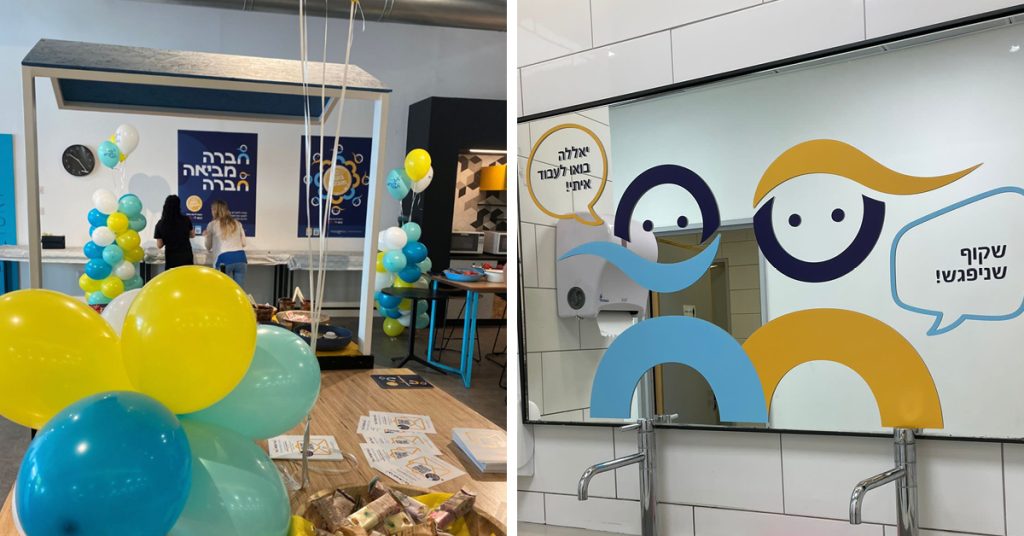
Maytronics - OZ Global B2B
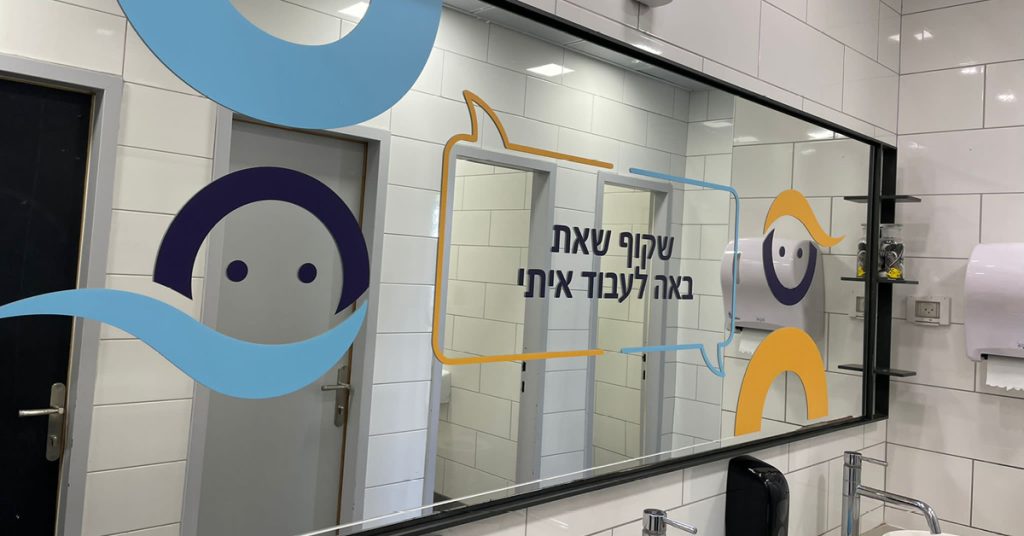

Branding 101 – The Branding Process Explained
By
Inbar Telem
, 03/09/2023
Want to know the secret sauce of branding? Our latest blog post has it all! Learn how inspiration fuels our journey, how design brings brands to life, and how businesses evolve through effective branding. Click here to uncover the branding recipe for success!

Step One – How to Start the Branding Process for a Business?
The start is life itself, because every day we're exposed to hundreds of messages, ideas, videos, texts, and images. Later it all comes together, and our mind begin processing all these inspirations into new, original, and unique design and language for a specific client. At Oz, we make sure our team, in this case, our designers, is exposed to diverse content worlds and various content styles. This opens up their minds to creativity, from which different brands for different companies can blossom (even if they're in the same industry, they'll create something unique and original – that's the beauty of it!). The branding process for a business begins as a strategic process where we research and analyze the brand, the product, the company, or the service – and answer the age-old questions – what is the company's vision, what makes the company special, what customers expect, and what the competition offers. To differentiate the brand effectively, it's essential to examine competitors – what visual and textual language they use, what messages they convey to the world, and what their customers think of them. During this examination, we come across tons of content and inspiration on the web, and it's a fantastic process. All the research and in-depth analysis, combined with the ideas and inspirations, meld together to form the foundation of the brand – the unique value proposition, the narrative, the promise, and the brand's values.
Step Two – How to Implement the Branding Process?
This is the step everyone seems to be familiar with – the name, logo, fonts, color palette. Supposedly. Since everyone talks about this step, it's crucial to understand that without a solid foundation and thorough research, it won't work. The brand's cornerstones (based on the strategic messages, remember?) need to be creatively and visually translated into the brand's language – both in verbal elements (the brand's name and slogan) and visual elements (the logo, fonts, shapes, and colors). The brand's domain, characteristics, and values will be expressed through its visual appearance. Importantly, the design should not only be eye-catching but should also have longevity. Trends come and go, but your branding should remain stable for years. Our designers have the ability to translate the emotional world into the visual world, making your target audience express positive emotions, identify with your brand, and remember your look (for the next time they encounter you) – or in short, to create an impactful brand for you.
Step Three – How Does a Business Change as a Result of Branding?
So, we've gathered inspiration, worked with a professional branding agency (like OZ, ahem), researched, and analyzed, and the designers have prepared sketches. And the most exciting part – the management approved it! So now what? Implementation! At the end of the branding process and the creation of the brand's visual language, it's time to infuse it into every marketing and reputation aspect of the company. The new language will be applied across the board – on social networks, envelopes, outdoor signs and ads, physical offices, pens and notebooks – anything that comes to mind (and if it doesn't, our client managers have plenty of ideas). Effective design is measured by its versatility. If the base has a strong and focused idea, it will be clear how to continue and develop that into the brand's language in every format – digital and print.Account Based Marketing (ABM) Vs. Lead Generation
By
Guy Toledano
, 17/08/2023
Are you struggling to decide between account-based marketing (ABM) and Lead Generation for your business? In this blog, we explore the key differences between the two strategies and how they can be used together to achieve optimal results. From understanding the benefits of demand generation to utilizing ABM for "land and expand" tactics. This guide provides valuable insights for marketers looking to boost their ROI. Additionally, the blog discusses how to effectively target the two main types of LinkedIn users to generate leads and increase engagement.
 While ABM and demand generation may seem like competing strategies, they can actually be used together to achieve optimal results. For example, demand generation can be used to create awareness and interest in a product or service, while ABM can be used to generate qualified leads and sign-up new customers.
This marketing tactic, can start with a broad-based demand generation campaign to create awareness, which will help to identify targeted leads or target market segments, which can then be used to inform a more targeted ABM campaign. An ABM activity can be used to reach out to specific named accounts with personalized content. These combined activities allow marketers to use both strategies to accelerate the buyer's journey and assist with selling.
It's also important to note that while ABM and demand generation are both outbound marketing strategies, inbound demand generation is also possible. By using inbound marketing tactics such as content marketing, SEO and other digital marketing strategies, you can drive leads and customers to your website and then use ABM to engage with them.
While ABM and demand generation may seem like competing strategies, they can actually be used together to achieve optimal results. For example, demand generation can be used to create awareness and interest in a product or service, while ABM can be used to generate qualified leads and sign-up new customers.
This marketing tactic, can start with a broad-based demand generation campaign to create awareness, which will help to identify targeted leads or target market segments, which can then be used to inform a more targeted ABM campaign. An ABM activity can be used to reach out to specific named accounts with personalized content. These combined activities allow marketers to use both strategies to accelerate the buyer's journey and assist with selling.
It's also important to note that while ABM and demand generation are both outbound marketing strategies, inbound demand generation is also possible. By using inbound marketing tactics such as content marketing, SEO and other digital marketing strategies, you can drive leads and customers to your website and then use ABM to engage with them.
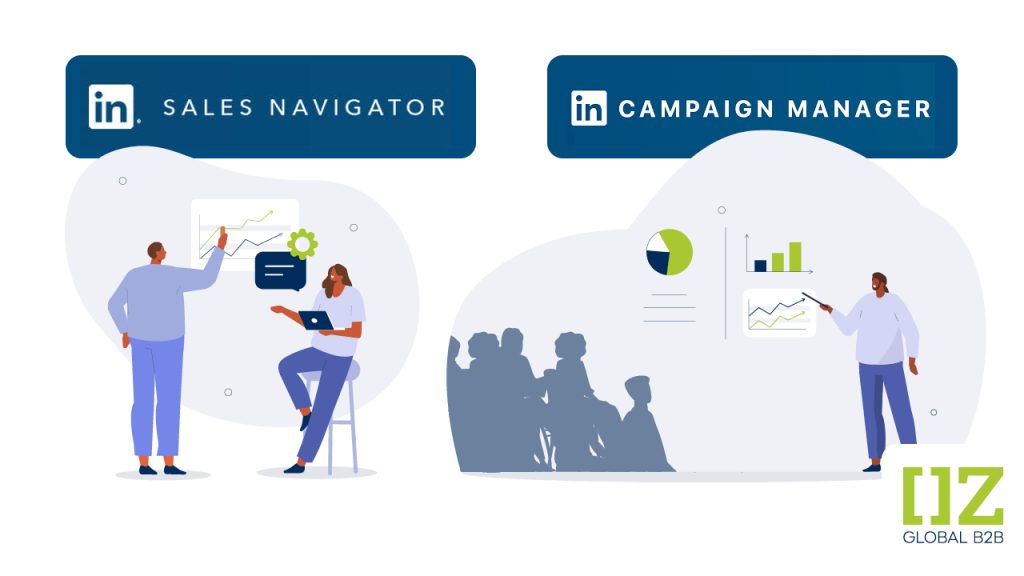 On LinkedIn, there are two primary types of users. The first group is known as "active users" and they exhibit a high level of engagement on the platform, such as performing searches, interacting with content, and sharing posts. These users also typically stay on top of their inbox and respond to relevant messages. These active users can be effectively targeted through an awareness campaign, followed by account-based marketing efforts.
The second main group of LinkedIn users are referred to as "basic users." These users tend to have a more limited level of activity on the platform, mostly just scrolling through their feed. They are less likely to respond to private messages. These basic users can be targeted through professional lead generation campaigns that will catch their attention while they are scrolling through their feed, with the use of an appealing message and creative content.
It is important to note that there are other types of users who fall somewhere between active and basic user, and by combining efforts of ABM with lead generation it will help in effectively reaching out to all types of users, with the right format and message.
In conclusion, account-based marketing and lead generation are both powerful strategies for generating revenue and boosting ROI. While they have their own unique benefits, it's important to understand how they can be used together to achieve optimal results. By using a targeted ABM approach in conjunction with a broad-based demand generation campaign, marketers can achieve their pipeline and revenue goals by capturing the attention of the right accounts and signing up new customers.
For more info and questions contact us.
On LinkedIn, there are two primary types of users. The first group is known as "active users" and they exhibit a high level of engagement on the platform, such as performing searches, interacting with content, and sharing posts. These users also typically stay on top of their inbox and respond to relevant messages. These active users can be effectively targeted through an awareness campaign, followed by account-based marketing efforts.
The second main group of LinkedIn users are referred to as "basic users." These users tend to have a more limited level of activity on the platform, mostly just scrolling through their feed. They are less likely to respond to private messages. These basic users can be targeted through professional lead generation campaigns that will catch their attention while they are scrolling through their feed, with the use of an appealing message and creative content.
It is important to note that there are other types of users who fall somewhere between active and basic user, and by combining efforts of ABM with lead generation it will help in effectively reaching out to all types of users, with the right format and message.
In conclusion, account-based marketing and lead generation are both powerful strategies for generating revenue and boosting ROI. While they have their own unique benefits, it's important to understand how they can be used together to achieve optimal results. By using a targeted ABM approach in conjunction with a broad-based demand generation campaign, marketers can achieve their pipeline and revenue goals by capturing the attention of the right accounts and signing up new customers.
For more info and questions contact us.
Is your website “Bing-ready”?
By
Orly Gilad
, 16/07/2023
This blog highlights essential points for SEO practitioners targeting Bing and Google. Topics include keyword research, social media integration, backlinks, local SEO, rich media content, and technical SEO. Stay updated with evolving algorithms for the best results. For more information, consult reputable SEO blogs and industry websites.
Here are some general points to consider when comparing SEO for Bing and Google:
- Keyword Research: While Bing and Google both consider keywords relevancy as an important factor for SEO, they may have different algorithms for how they interpret and rank keywords. It's important to research and optimize for search terms that are relevant to both Bing and Google search results. ➭ For example, After conducting keyword research, you may find that [your company solution] + USA are popular search terms on both Bing and Google. By optimizing your content for these keywords, you'll increase the chances of appearing in search results on both search engines.
- Social Media Integration: Bing tends to give more importance to social media integration and social signals, such as social media shares, likes, and comments, compared to Google. Incorporating social media strategies into your SEO efforts may be more beneficial for Bing rankings, so be sure to promote your content on social media platforms like LinkedIn, Twitter, and Facebook, encouraging shares, likes, and comments to improve Bing rankings.
- Backlinks: Both Bing and Google consider backlinks as an important ranking factor, but they may have different algorithms for evaluating the quality and relevance of backlinks. It's important to understand the differences and optimize your backlink strategy accordingly. ➭Request backlinks from authoritative industry websites or thought leaders to enhance your website's credibility and rankings on both Bing and Google.
- Local SEO: Bing tends to place more emphasis on local search results compared to Google. Optimizing your website for local SEO, by including location-specific keywords like "top Global B2B agencies in [Israel]" ;) will help optimize your local listing, and getting local citations, will be beneficial for both Bing and GMB rankings.
- Rich Media Content: Bing tends to place more importance on rich media content, such as images and videos, compared to Google. Including relevant images and videos with proper optimization may help improve your rankings on Bing.
- Technical SEO: Both Bing and Google consider technical SEO factors, such as website speed, mobile-friendliness, and crawlability. Optimizing your website's technical aspects according to the guidelines of both search engines can help improve your SEO performance on both Bing and Google.
➭ To find the technical guidelines for both Bing and Google, you can refer to the official documentation and resources provided by each search engine:
Additionally, both Bing and Google offer webmaster tools that provide insights into your website's performance, indexing status, and potential issues. These tools can help you optimize your website according to the search engine guidelines, improving your overall SEO performance.
- Bing Webmaster Tools: https://www.bing.com/webmasters/
- Google Search Console: https://search.google.com/search-console
Will AI be the end of SEO?
By
Orly Gilad
, 14/06/2023
As ChatGPT gains momentum, concerns are growing regarding its impact on everything from coding to SEO. It depends on who you ask, but the current consensus is that AI is not likely to kill Search Engine Optimization. In fact, it may actually prove quite useful in enhancing and optimizing SEO efforts. AI-powered technologies can provide insights, automate tasks, and improve the efficiency of SEO strategies.
As ChatGPT gains momentum, concerns are growing regarding its impact on everything from coding to SEO.
It depends on who you ask, but the current consensus is that AI will not likely kill Search Engine Optimization. It may actually prove quite useful in enhancing and optimizing SEO efforts. AI-powered technologies can provide insights, automate tasks, and improve the efficiency of SEO strategies. If it’s repetitive and time-consuming, AI has got you covered Why spend time on keyword research, competitor analysis, and content optimization, when you can be focusing on strategic planning and higher-level tasks? Here are three key ways AI can help:- Data Analysis AI can process and analyze large amounts of data quickly and accurately, which can help identify patterns, trends, and opportunities for SEO optimization. This can include analyzing search data, website analytics, and user behavior data to inform SEO strategies and tactics.
- Content OptimizationAI-powered content generation tools can assist in creating high-volume and optimized content. These tools can provide insights on keyword usage, content structure, readability, and relevance to improve the overall quality of content for SEO purposes.
- PersonalizationAI can analyze user data and behavior to deliver personalized search results and content recommendations. This can help improve user engagement and satisfaction, which can indirectly impact SEO rankings.

AI is your assistant, not your replacement
AI can’t replace human expertise in SEO. SEO professionals will still play a crucial role in interpreting and implementing the insights provided by AI, as well as adapting SEO strategies to changing algorithms, user behaviors, and business goals. AI tools can be powerful to support and enhance SEO efforts, but human creativity and strategic thinking will remain crucial in the SEO landscape.How can you utilize ChatGPT for SEO purposes?
Here are its suggestions:- Content Generation: Use ChatGPT to generate ideas for quick content for your website, blog, or social media posts. You can input keywords, topic ideas, or specific questions related to your SEO strategy, and ChatGPT can generate content that aligns with your SEO goals.
- Keyword Research: Utilize ChatGPT to brainstorm and generate keyword ideas for your SEO campaigns. You can input seed keywords or topic ideas, and ChatGPT can generate a list of related keywords that can help you identify opportunities for content creation and optimization.
- Meta Tags Optimization: Use ChatGPT to generate optimized meta tags, including title tags and meta descriptions, that are relevant to your target keywords and audience. ChatGPT can provide suggestions and variations for meta tags that can improve your website's click-through rates (CTRs) and search engine visibility.
- SEO Content Optimization: Input your existing content into ChatGPT to get suggestions on how to optimize it for SEO. ChatGPT can provide recommendations on improving content structure, keyword placement, and readability to make your content more search-engine-friendly.
- On-Page SEO: Use ChatGPT to get suggestions on optimizing various on-page SEO elements, such as headings, image alt tags, and URL structure. ChatGPT can provide insights on how to improve these elements for better search engine visibility and user experience.
- SEO Strategy assistance: Utilize ChatGPT to brainstorm and generate ideas for your overall SEO strategy, including content topics, and social media integration. ChatGPT can provide wide suggestions and insights that can inform your SEO planning and execution.
- SEO Troubleshooting: Input specific SEO challenges or issues into ChatGPT to get insights and suggestions on how to resolve them. ChatGPT can provide troubleshooting tips and recommendations to overcome common SEO obstacles.
 While ChatGPT can provide valuable insights and suggestions for SEO purposes, it's still essential to use human judgment and expertise in evaluating and implementing the recommendations.
SEO best practices may vary depending on your specific industry, audience, and search engine algorithms, so it's crucial to conduct thorough research and consult with SEO professionals to build a comprehensive SEO strategy.
While ChatGPT can provide valuable insights and suggestions for SEO purposes, it's still essential to use human judgment and expertise in evaluating and implementing the recommendations.
SEO best practices may vary depending on your specific industry, audience, and search engine algorithms, so it's crucial to conduct thorough research and consult with SEO professionals to build a comprehensive SEO strategy.
Watch Google's update on Search Generative Experience:
HubSpot – Marketing, ROI, and everything in between
Speaker: Dor Rotschild
Hebrew Webinar - marketing managers and sales managers who want to know what really happens in the connection between the marketing and sales processes in your company, and how the connection contributes to ROI and results.
How to Meet & Influence Your Door Openers
Speakers: Nirit Elyovich and Rivi Kesten
The Door Openers strategy will bring you directly to the key people who will open the door for your company.
Don’t say you didn’t see it coming
In October 2020, Google announced that it would discontinue Universal Analytics and shift to Google Analytics 4 (GA4). But don’t worry, we’ve got you covered with our step-by-step guide on how to switch from Universal Analytics to GA4, discuss the differences between these two versions of GA, and highlight some of the benefits of GA4.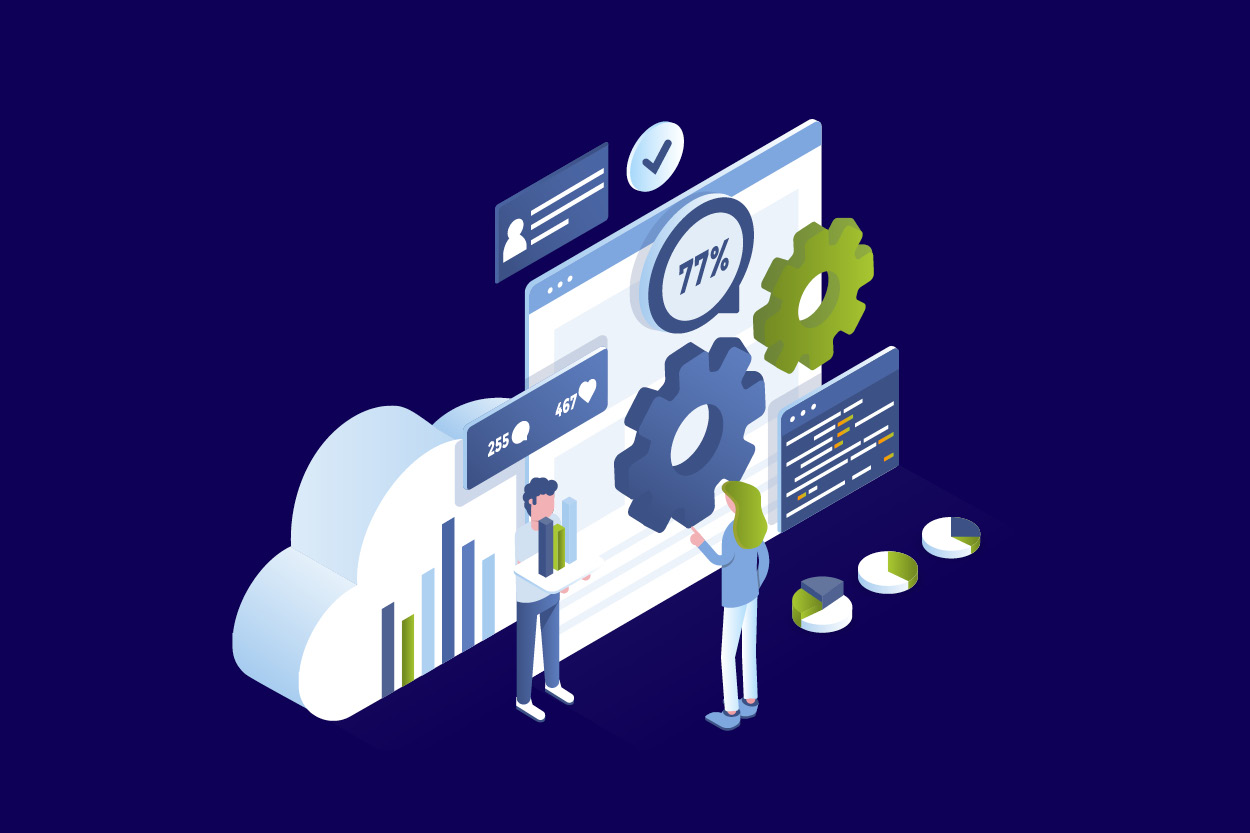
The clock is ticking
From July 2023, the free version of GA will no longer gather data. That means if you want to continue using Google Analytics, you must switch to GA4. Take note, you will be able to access your previously processed data in your Universal Analytics property for at least six months. However, you won’t be able to view your Universal Analytics reports or interact with your analytics data via the API. This change will affect all website owners who rely on their Google Analytics account as their main data source for audience demographics, behavior, and areas of interest.What’s the difference between Google Analytics and GA4?
If you want to know how your users are interacting with your website or app, you need effective event tracking which allows you to track specific user interactions – such as button clicks, video plays, and form submissions. In the past, you needed to set it up manually, adding code snippets to your website or app to track specific events, which was challenging to manage. The good news is that G4 has already set it up for you and you can configure event tracking without coding. While the focus used to be on calculating site sessions and monitoring audiences, it’s now moved to what audiences are actually doing on your site. GA4 offers parameters, enhanced measurement, and in-platform event creation (replacing action, category, and label). When setting up the data stream, you can turn on enhanced measurement to automatically collect page views, downloads, outbound clicks, video engagement, and scrolls. Conditions and parameters (which provide context on the user or user actions) cover events that don’t fall under enhanced measurement. Take note that you can mark events as conversions which eliminate the need for goal setup.There are four types of events covered in GA4:
-
Automatically collected events

-
Enhanced measurement events
-
Recommended events

-
New G44 features
- Link to Google Merchant Center, Google Optimize, and BigQuery natively and for free
- Create custom reports in GA4 and add those reports right to your navigation
- Custom dashboards combining two tools in one —taking the data from UA and Data Studio
Gee, four sounds great!
Switching to GA4 allows you to take advantage of all the new advanced features and get the most out of your data. There isn’t much time left to make the move, so if you haven’t already started, it’s time to make the switch now. Ready to make the switch? Our SEO team will walk you through it.From a Simple PPT to a Winning Presentation
Speakers: Rivi Kesten Buk and Nevo Levin
Practical Tips for PowerPoint Presentations From Oz's Experts
Move over Google Analytics, GA4 is coming to your website soon
By
Orly Gilad
, 17/05/2023
You’re probably familiar with Universal Analytics, the Google Analytics (GA) tool that has been around for more than a decade, providing website owners and publishers with insights into their website’s performance. But in July 2023, it’s being replaced by GA4. Are you ready for the switch?
Don’t say you didn’t see it coming
In October 2020, Google announced that it would discontinue Universal Analytics and shift to Google Analytics 4 (GA4). But don’t worry, we’ve got you covered with our step-by-step guide on how to switch from Universal Analytics to GA4, discuss the differences between these two versions of GA, and highlight some of the benefits of GA4.
The clock is ticking
From July 2023, the free version of GA will no longer gather data. That means if you want to continue using Google Analytics, you must switch to GA4. Take note, you will be able to access your previously processed data in your Universal Analytics property for at least six months. However, you won’t be able to view your Universal Analytics reports or interact with your analytics data via the API. This change will affect all website owners who rely on their Google Analytics account as their main data source for audience demographics, behavior, and areas of interest.What’s the difference between Google Analytics and GA4?
If you want to know how your users are interacting with your website or app, you need effective event tracking which allows you to track specific user interactions – such as button clicks, video plays, and form submissions. In the past, you needed to set it up manually, adding code snippets to your website or app to track specific events, which was challenging to manage. The good news is that G4 has already set it up for you and you can configure event tracking without coding. While the focus used to be on calculating site sessions and monitoring audiences, it’s now moved to what audiences are actually doing on your site. GA4 offers parameters, enhanced measurement, and in-platform event creation (replacing action, category, and label). When setting up the data stream, you can turn on enhanced measurement to automatically collect page views, downloads, outbound clicks, video engagement, and scrolls. Conditions and parameters (which provide context on the user or user actions) cover events that don’t fall under enhanced measurement. Take note that you can mark events as conversions which eliminate the need for goal setup.There are four types of events covered in GA4:
Automatically collected events GA4 automatically collects pageviews, scrolls, and outbound clicks without the need for additional coding.
Enhanced measurement events
Here’s where things get a bit more complex. These events usually track interactions such as page views, file downloads, form interactions, scrolls, outbound clicks, site search, and video engagement that can’t be easily by standard events and require extra coding before GA4 can collect these events and provide reports.Recommended events
Behind the scenes, GA4 gathers data on your site activity and makes recommendations on events you may want to consider tracking, such as frequent outbound link clicks.
New G44 features
- Link to Google Merchant Center, Google Optimize, and BigQuery natively and for free
- Create custom reports in GA4 and add those reports right to your navigation
- Custom dashboards combining two tools in one —taking the data from UA and Data Studio
Gee, four sounds great!
Switching to GA4 allows you to take advantage of all the new advanced features and get the most out of your data. There isn’t much time left to make the move, so if you haven’t already started, it’s time to make the switch now. Ready to make the switch? Our SEO team will walk you through it.It’s not you, it’s Google!
By
Orly Gilad
, 02/05/2023
Did Your Search Engine Rankings Drop Suddenly? It’s Not You, it’s Google! When you’ve worked hard to get your website ranking high in Google’s results, it can be disturbing when they experience a sudden drop. We’d tell you not to panic, but it doesn’t really work. Actually, if you see other webmasters panicking, chances are you should be too.
 A good place to start is the Google Search Console. You’ll find that it’s a valuable tool for tracking and optimizing your website's rankings in Google search results. Take a look at your analytics and check your manual action report.
Making major changes to your site may have an impact on your rankings. Take a look at your website traffic to see if there are any noticeable changes or trends. Reviewing your site statistics may provide some useful data and actionable insights.
By leveraging the information provided by the console, you can make informed decisions and implement effective strategies to improve your website's performance and rankings.
A good place to start is the Google Search Console. You’ll find that it’s a valuable tool for tracking and optimizing your website's rankings in Google search results. Take a look at your analytics and check your manual action report.
Making major changes to your site may have an impact on your rankings. Take a look at your website traffic to see if there are any noticeable changes or trends. Reviewing your site statistics may provide some useful data and actionable insights.
By leveraging the information provided by the console, you can make informed decisions and implement effective strategies to improve your website's performance and rankings.
It’s not you? It could be Google
Google makes updates every single day, a couple of times a day. A Google update in February caused a lot of volatility. Here’s the bad news: experts say Google’s volatility will continue to intensify. Tools such as Semrush Sensor can help with assessing SERP volatility. Remember, SEO is an ongoing process, so ranking fluctuations are inevitable. By monitoring, analyzing, and optimizing your website's performance regularly, you can improve your rankings and drive more targeted organic traffic to your website over time.To stay informed of the up and downs, follow Google Search Status updates, or SEO news sites and blogs.
How to Identify and Meet Your Door Openers
By
Nirit Elyovich
, 26/03/2023
How to Identify and Meet Your Door Openers How can you identify and get to know the people who are in the right position to open the door for you? In a recent webinar, Nirit Elyovich, our VP Strategy, shared some key insights.
- Who are the door openers?
- How can you get to know them better?
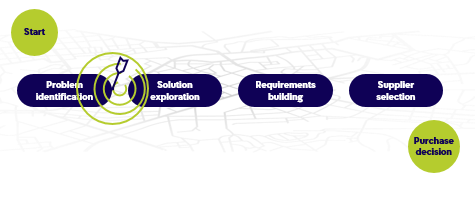 1. Stay as close to the beginning of the purchase journey as possible
The role of marketing is to generate demand. The earlier we meet the interested parties at the beginning of the purchase journey, the more we will increase our chances of entering the consideration set — to be one of the suppliers they are considering.
This is the point when they realize that there is a problem. As the need arises, they begin to learn about the alternatives that exist in the market. It's time for you to enter the picture.
Key takeaway: Find the earliest point in the purchase journey, even before your potential customers start contacting suppliers.
2. Expand your search beyond the obvious and cast a wider net – to influencers and KOLs
Entire industries are undergoing a shake-up and need to update their business strategy. In this scenario, it’s strategic consulting companies that will be recommending new business directions to them. If a high-profile consulting company recommends you, you’ve done your part. Obviously, they won't recommend you if they don't know about you. But if you recognize them as the ones who can open the door for you and you bring your company to their attention, new horizons will open up for you.
If you’re working in the same space with complementary companies, leverage it. As an example, companies in the agritech space are all targeting the same growers. They don’t compete but complement one another. Growers are already working with a company trusts them. If they recommend you, then your chances of setting a meeting and staying to build a relationship, are far greater.
Key takeaway: Differentiate yourself and try to reach your door openers through avenues that others haven’t yet discovered.
3. Copy your ideal customer
Think of a customer of yours that you would like to duplicate. Your potential dream client — the one who, if you get it right, will allow you to duplicate your offer to lookalike clients.
It’s really what a persona is all about — a typical figure that represents your target audience. The idea is to learn from the individual and expand it to a broader audience. If it’s too niche and cannot be replicated, it won't really help you.
Key takeaway: If it works, do it again!
How can you get to know your door openers better?
Each persona has their own "buttons", that when pushed cause them to act. If you know what motivates your door openers, you’ll be able to reach them. That's why it's important to build a profile for each persona you’ve chosen.
1. Stay as close to the beginning of the purchase journey as possible
The role of marketing is to generate demand. The earlier we meet the interested parties at the beginning of the purchase journey, the more we will increase our chances of entering the consideration set — to be one of the suppliers they are considering.
This is the point when they realize that there is a problem. As the need arises, they begin to learn about the alternatives that exist in the market. It's time for you to enter the picture.
Key takeaway: Find the earliest point in the purchase journey, even before your potential customers start contacting suppliers.
2. Expand your search beyond the obvious and cast a wider net – to influencers and KOLs
Entire industries are undergoing a shake-up and need to update their business strategy. In this scenario, it’s strategic consulting companies that will be recommending new business directions to them. If a high-profile consulting company recommends you, you’ve done your part. Obviously, they won't recommend you if they don't know about you. But if you recognize them as the ones who can open the door for you and you bring your company to their attention, new horizons will open up for you.
If you’re working in the same space with complementary companies, leverage it. As an example, companies in the agritech space are all targeting the same growers. They don’t compete but complement one another. Growers are already working with a company trusts them. If they recommend you, then your chances of setting a meeting and staying to build a relationship, are far greater.
Key takeaway: Differentiate yourself and try to reach your door openers through avenues that others haven’t yet discovered.
3. Copy your ideal customer
Think of a customer of yours that you would like to duplicate. Your potential dream client — the one who, if you get it right, will allow you to duplicate your offer to lookalike clients.
It’s really what a persona is all about — a typical figure that represents your target audience. The idea is to learn from the individual and expand it to a broader audience. If it’s too niche and cannot be replicated, it won't really help you.
Key takeaway: If it works, do it again!
How can you get to know your door openers better?
Each persona has their own "buttons", that when pushed cause them to act. If you know what motivates your door openers, you’ll be able to reach them. That's why it's important to build a profile for each persona you’ve chosen.
 Every persona, even in the same organization, is motivated by different things. There’s no single message that motivates everyone. To get a clearer picture, ask yourself these questions:
Every persona, even in the same organization, is motivated by different things. There’s no single message that motivates everyone. To get a clearer picture, ask yourself these questions:
- What tasks need to be done — What is on the decision maker’s plate? Typically, people only listen if it’s in their scope of activity. This is critical!
- What are the aspirations of each persona — What do they want to achieve within their role? In short, what are their “gains?”
- What are their pain points — What makes it difficult to achieve their goals?
 To convince someone to let you in the door, they must be convinced that it will bring significant value both to the company and themselves.
Meir Ariel sings, "The doors guess who I am and open by themselves." It would be great if that was true in the business world, where the doors we are looking don’t recognize us and won’t open by themselves.
Knock, knock, knocking on the right door
To sum up, when you focus on the beginning of the customer journey, expand your view to less obvious places, and know which persona profile you’re looking for, there’s a good chance you will reach the people who can open the door for you. Then all you have to do is enter.
To convince someone to let you in the door, they must be convinced that it will bring significant value both to the company and themselves.
Meir Ariel sings, "The doors guess who I am and open by themselves." It would be great if that was true in the business world, where the doors we are looking don’t recognize us and won’t open by themselves.
Knock, knock, knocking on the right door
To sum up, when you focus on the beginning of the customer journey, expand your view to less obvious places, and know which persona profile you’re looking for, there’s a good chance you will reach the people who can open the door for you. Then all you have to do is enter.
UX/UI trends in the B2B world – What to take & leave behind in 2023
By
Naomi Lifshitz
, 18/01/2023
When I just started my career, an intelligent woman told me that only when I understand.
- What’s on the menu? “When planning the user experience, we have to put ourselves in our users’ shoes. We all have limited time and between work, home, and family, we don't have time to scroll through endless websites in the search for information,” says Naomi.
- Make some space!
- Give the footer the respect it deserves “Just because the footer’s at the bottom of the website doesn’t mean it doesn’t deserve a place of honor,” notes Naomi. “While the footer may be located on the ’fringe’ of the site, we shouldn’t treat it as such. When specifying the site structure every part of the site is important. We’re not going to add unnecessary pages or elements to the site, but the footer appears on every page and needs to be designed accordingly.”When building a brand strategy for businesses, it’s important that it speaks the same language – everywhere it appears – and that includes the footer. Give it space and design it in a brand-compatible manner, incorporating creative brand elements and enticing messaging. Scroll down to Unilog’s footer to see how it reflects the brand’s personality.
- No more excuses! That’s so yesterday “Leave the excuses why you can’t build a website in 2022,” says Naomi, adding that, “Many businesses avoid building a website on the grounds that they don’t have sufficient budget, information, or products to build a complete site. But keeping your website short and to the point puts paid to that excuse.”
Consumerize the Customer Journey
By
Nirit Elyovich
, 25/01/2022
Early in my career, a wise woman said customers pay my salary, not owners. It's vital for marketers to consider future customers' needs.
The new B2B customer is a digital native
Our childhood determines our future behaviors as adults, the people we become, and the decision-makers we grow up to be. It is also true of the technological environment in which we were raised.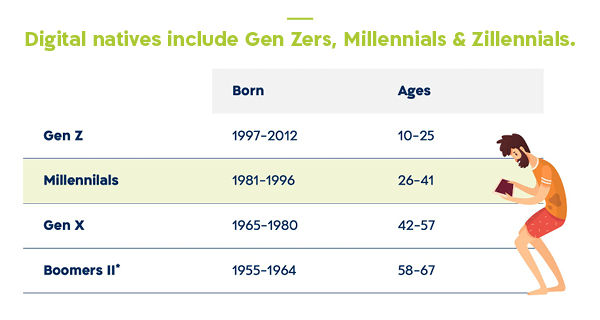 The millennials, also known as Generation Y, were born after 1980. They are now in their 30’s. Generation Z, as you can see in the table, is still young, but we will soon see them influencing our businesses. Since technology is changing very quickly, a sub-generation was born between the Millennials and Generation Z. Zillennials were born between ‘93-‘98 and were influenced by more advanced technology than the Millennials.
For their entire lives, digital natives have been surrounded by technology, social media, mobile devices, computers, and the internet. They speak this digital language as their mother tongue. They did not learn this language in their 20’s, 30’s, or later. They do not have an accent, so to speak.
The millennials, also known as Generation Y, were born after 1980. They are now in their 30’s. Generation Z, as you can see in the table, is still young, but we will soon see them influencing our businesses. Since technology is changing very quickly, a sub-generation was born between the Millennials and Generation Z. Zillennials were born between ‘93-‘98 and were influenced by more advanced technology than the Millennials.
For their entire lives, digital natives have been surrounded by technology, social media, mobile devices, computers, and the internet. They speak this digital language as their mother tongue. They did not learn this language in their 20’s, 30’s, or later. They do not have an accent, so to speak.
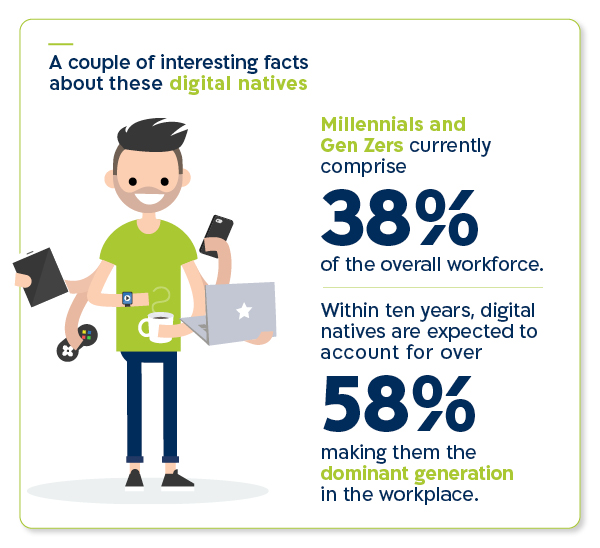
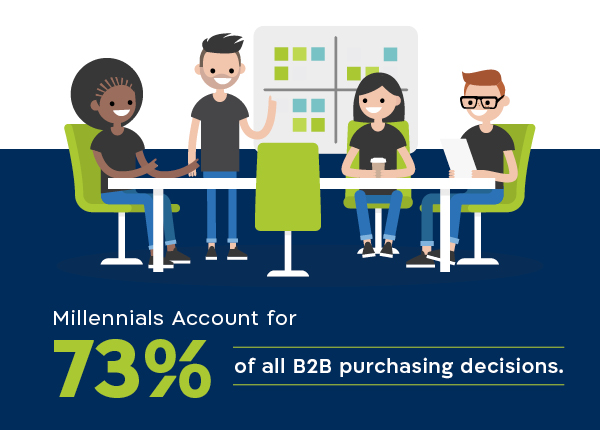 This impressive figure tells the whole story: More and more millennials and gen zers are entering the B2B decision journey, some as technological or professional influencers and others as decision-makers. It is important to note that among the people involved in decision-making, you usually meet several generations.
A few months ago, we at Oz Global B2B did a project for the American agricultural market. The intergenerational integration in the decision-making process that arose there was very prominent.
This impressive figure tells the whole story: More and more millennials and gen zers are entering the B2B decision journey, some as technological or professional influencers and others as decision-makers. It is important to note that among the people involved in decision-making, you usually meet several generations.
A few months ago, we at Oz Global B2B did a project for the American agricultural market. The intergenerational integration in the decision-making process that arose there was very prominent.
-
- A family business where the younger generation initiates a decision, and the founding generation approves it. Sometimes the founder initiates the decision but immediately passes it on to the younger generation to check online what the options are.
- A senior manager at a big business closes a deal, but the people in the field - professionals or salespeople - do not “speak” the same language. This will greatly affect the next purchase.
The Millennials and Gen Zers highly influence who will enter the decision funnel
About 50% of all product searches on the web are conducted by digital natives. The customer journey is long, complex, and involves many stakeholders.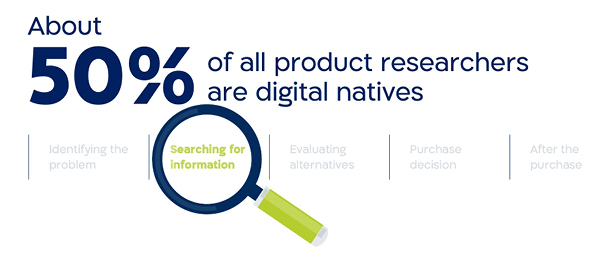 By the time the customer recognizes that he has a problem, we are, in most cases, not there. Identification is an internal stage from which someone is appointed to start researching information to find options for a solution.
50% of those who conduct the research and seek alternatives regarding a product or service, may not take an "official" part in decision-making but are the ones who put the relevant suppliers in the decision-making funnel. They are the ones who build the long list. They are the ones who decide whether or not you will be included in the “consideration group,” which is of critical importance.
By the time the customer recognizes that he has a problem, we are, in most cases, not there. Identification is an internal stage from which someone is appointed to start researching information to find options for a solution.
50% of those who conduct the research and seek alternatives regarding a product or service, may not take an "official" part in decision-making but are the ones who put the relevant suppliers in the decision-making funnel. They are the ones who build the long list. They are the ones who decide whether or not you will be included in the “consideration group,” which is of critical importance.
Two tips to gain the trust of digital natives:
1. Be authentic!
The generation that grew up on social networks, fake news, and unfounded marketing does not believe in marketing messages and does not believe in unproven statements. They have developed a hypersensitivity to online messages - they suffer from a blatant lack of trust in what is being said online. They continue to consume information online, but with a very large firewall. The bright side of it is that digital natives recognize authenticity when they see it..So what does authentic marketing look like?
-
- Get your executives to use social media Customers want to know the people behind the executives or the company representatives that they are in contact with.Make sure your site reveals who you are beyond your formal title. What topics do you choose to share? Who are your friends, what groups do you belong to, and to whom do you respond to?LinkedIn is not everything. Feel free to diversify to other social networks - Facebook, Instagram, Twitter, and even Tik Tok.
- Share user-generated content from real people Show real things, with real customers behind them. If you trust your product, let it tell your story.
- Go live on social media platforms Talk without filters. To digital natives this sounds obvious, to digital immigrants, it is less trivial. At first, the digital immigrants posted posts after editing them numerous times. Then they agreed to post an edited video. The transition to live video is scarier, but this is exactly the meaning of authenticity.
- Promote employee advocacy Empower your employees to share smart, quality content with their own social networks. On average, employee networks have 10x more connections than a company has followers. Plus, according to the Edelman Trust Barometer, people are 3x more likely to trust company information shared by an employee than that shared by a CEO.
2. Consumerize!
This word does not exist in the dictionary yet but already stars in the literature that follows trends in the B2B world. As Mona Akmal, Falkon CEO and Cofounder, once said, “As work and life flexibly intertwine, so must our approach to reaching our target users.” Gone are the days when the customer was a business person between 9-17 and a consumer on evenings and weekends. Studies show that the business customer is very much influenced by his consumer experience and expects to have a similar experience in business purchases. The customer experience touches on all stages of the journey - collecting information, placing an order, contacting the company up to paying.- More than 80% of B2B customers stated that they will look for a new supplier if their expectations in terms of customer service and user experience are not fulfilled.
- According to McKinsey & Co, B2B brands score below 50% on customer experience index ratings on average, compared to 65 to 85% for typical B2C brands.
- Gartner illustrates that 77% of B2B buyers report that their last purchase was very difficult or complex.
To sum up…
- The digital natives are digital animals. They were born into it, and it is their playground. It requires us to be present and comfortable in the digital space. Allow them to find us easily and learn about us in a convenient way that interests them. Allow them to easily consult, purchase and pay online.
- Life in the digital arena has taught them to be suspicious, not to believe everything they are told. They have developed the skills and expertise to recognize fake news when they see it. This requires us to be authentic in interactions with them, without filters and edits.
- Remember, before they are decision-makers, customers, or partners, they are first and foremost human beings. Their personal lives have seeped into their business life and it is very difficult for them to separate the two. So, we have no choice but to "consumerize" the way we treat them.
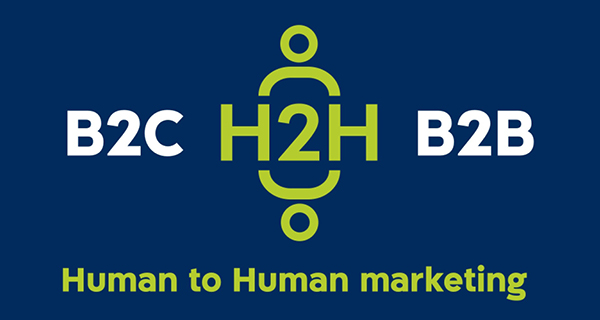
How to Get Started with B2B Videos
By
Liane Shalev
, 26/09/2019
When’s the last time you watched a video? Today? Yesterday?
Key takeaways from HUG Haifa #2, “All About Video”
When’s the last time you watched a video? Today? Yesterday? That puts you in good company. Humans love video. 1/3 of all time online is spent watching videos. In fact, 500 million people watch a video on Facebook every day. And here’s another mindboggling stat for you: Adding a video to your website can improve the chance of a front-page Google result by 53%. That’s right. It doubles your chances of getting onto the first page of Google. Yes, video is big. Yes, it needs to be an important part of your B2B marketing strategy. And no, it’s not nearly as hard as you think to get started with video. From tactic to strategy
Video has changed a lot in the past six years, points out Maria Trubicina, Senior Customer Success Manager at HubSpot. In 2013, videos were mostly passively watched on desktop or YouTube, hard to create and made by a few; in 2019, videos are actively watched on mobile or social, easy to create, and made by many.
This calls for a change – moving from video as a tactic (made by a creative team, highly produced, expensive, one to many, an awareness play, unmeasurable), to a strategy (made by all teams, low production, cheap, actionable, BOFU and measurable.)
Listen up!
To create relevant, actionable and engaging videos you need to get all your teams involved. That means talking to sales, quality control, production, legal, and even accounts. Every department will have a unique perspective about your product or service that you may not have even thought of. One video does not fit all. Each video needs to be tailored to the specific target market and goal. Make it simple. And keep it real.
What kind of videos should you be creating?
You’ll need to develop targeted videos for every stage of the flywheel and for every purpose – attract, engage and delight – and modify them to meet the needs of the specific channel (YouTube, social media, website).
From tactic to strategy
Video has changed a lot in the past six years, points out Maria Trubicina, Senior Customer Success Manager at HubSpot. In 2013, videos were mostly passively watched on desktop or YouTube, hard to create and made by a few; in 2019, videos are actively watched on mobile or social, easy to create, and made by many.
This calls for a change – moving from video as a tactic (made by a creative team, highly produced, expensive, one to many, an awareness play, unmeasurable), to a strategy (made by all teams, low production, cheap, actionable, BOFU and measurable.)
Listen up!
To create relevant, actionable and engaging videos you need to get all your teams involved. That means talking to sales, quality control, production, legal, and even accounts. Every department will have a unique perspective about your product or service that you may not have even thought of. One video does not fit all. Each video needs to be tailored to the specific target market and goal. Make it simple. And keep it real.
What kind of videos should you be creating?
You’ll need to develop targeted videos for every stage of the flywheel and for every purpose – attract, engage and delight – and modify them to meet the needs of the specific channel (YouTube, social media, website).
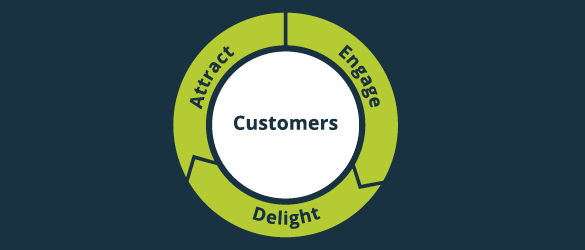
- Attract videos expand reach and build trust and credibility with your audience.
- Engage videos convert your visitors into leads and ultimately close them as customers.
- Delight videos encourage customers to embrace your brand and become brand evangelists.
- Increase brand awareness and attract customers to your site
- Help your prospects consider your solution to solve their problem
- Help your leads decide to do business with you
 Where do you get the content from?
Chances are, you already have it. Take a look at your existing content. Which web pages were visited the most? What calls to action did users click on? What blogs were the most successful? Repurpose them into compelling stories. But make sure your video answers the key question your potential customers at the Attract and Engage stage are going to ask before deciding to watch or ignore your video: What’s in it for me? How are you solving MY problems?
Hold it! Don’t make these three mistakes.
Video content specialist Sivan Felder, from Two Heads Consulting, points out that many B2B companies make these mistakes:
Where do you get the content from?
Chances are, you already have it. Take a look at your existing content. Which web pages were visited the most? What calls to action did users click on? What blogs were the most successful? Repurpose them into compelling stories. But make sure your video answers the key question your potential customers at the Attract and Engage stage are going to ask before deciding to watch or ignore your video: What’s in it for me? How are you solving MY problems?
Hold it! Don’t make these three mistakes.
Video content specialist Sivan Felder, from Two Heads Consulting, points out that many B2B companies make these mistakes:
- You’re not the hero of the story. This isn’t about you. It’s about your customer (the hero) who has a crisis. He meets a guide (your company). And thanks to your product or service, he survives or thrives.
- The laws of human psychology apply to your target customer as well. Behind every rational purchasing decision is an emotion. Identify it and speak to it. Help your prospective customers out of confusion and into clarity. And remember to tell them what they need to hear (as opposed to what you want to say.)
- A one-size-fits-all video. We’ve already said it, but we’ll say it again. Your customers want to hear different things from you at different stages. What are the touchpoints? Where are customers going to come into contact with your video and how are you planning to get your video out there?
- Play rate — the percentage of people who played your video divided by the number of impressions)
- Clickthrough rate — the number of times your call to action is clicked divided by the number of times its viewed
- Conversion rate — the number of times your visitors completed your desired action divided by the number of clicks on your call to action
- Make your videos an interactive experience. Use smart CTAs and embedded forms.
- Increase SEO effectiveness. Finetune your meta info to make it easy for search engines to find you.
- Monitor performance. Keep track of your video views, clickthroughs and conversions, so you can optimize them accordingly.
- Build relationships. Record one-to-one videos directly from the CRM and send directly from email.
- Provide better customer service. Use videos to improve the service experience and provide helpful tips or troubleshooting advice.
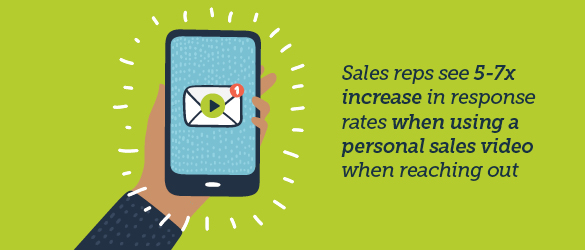 Video goes way beyond creating awareness and nurturing leads. It can also help you build relationships and excel in customer service.
Ready? Hit record!
If you have HubSpot and want to get started with video marketing, contact us!
Don’t miss out! Join a HUG
These great tips are just a taste of what we talked about during our HubSpot User Group meeting, All About Videos. HubSpot makes it easy to make video an integral part of your marketing mix. Take advantage of all these great resources. Get some practical advice on how to get started with video marketing. Or take one of HubSpot’s great free video courses.
Video goes way beyond creating awareness and nurturing leads. It can also help you build relationships and excel in customer service.
Ready? Hit record!
If you have HubSpot and want to get started with video marketing, contact us!
Don’t miss out! Join a HUG
These great tips are just a taste of what we talked about during our HubSpot User Group meeting, All About Videos. HubSpot makes it easy to make video an integral part of your marketing mix. Take advantage of all these great resources. Get some practical advice on how to get started with video marketing. Or take one of HubSpot’s great free video courses.
HUG Haifa – SALES & MARKETING ALIGNMENT
By
Jonathan Cohen
, 08/08/2019
The HUG Haifa debut was a triumph. We gained insights from HubSpot's Stephen Fuery and BERMAD's Ofir Marx, which will advance our Marketing and Sales projects.
- 87% Of the terms sales & marketing use to describe each other are negative
- 20% - The amount of revenue increase companies with strong sales & marketing are able to achieve.
- I don’t know if the sales team is working my leads
- I don’t know the ROI of my marketing campaigns
- I’m getting too many leads and can’t prioritize them
- I don’t know what to do with these Marketing leads.
Service Level Agreement (SLA)
This is a commitment between Marketing & Sales to deliver on specific goals. How do you create an SLA? Glad you asked ?. Use Historical data to understand your goals, putting into consideration the common goals between the two teams. Ask yourself these questions as a roadmap to creating an SLA that serves both the marketing and sales teams:- How many MQL’s is Marketing creating?
- Are Sales working MQL’s?
- At what rate are MQL’s converting to Customers?
- What % of deals are attributed to Marketing?
Decide on future SLA’s and build reports to measure them, presenting SMART (Specific, Measurable, Actionable, Relevant, Timely) goals.
Let’s compare: Goal 1: I want more website visitors, leads and sales. But this is too general, what about? Goal 2: I need 20,000 visitors, 500 leads, 12 customers within 12 months in order to achieve our revenue goal of $600,000 from Inbound. Goal 2 is a SMART goal. It will give you a complete picture of what you want to achieve.Agree on Fit
This is a measurement of how well you could serve a lead if they were to become a customer.Segmentation:
Let’s divide segmentation into two parts:- Lifecycle stage: a way of categorizing where any given contact or company is within your marketing and sales flywheel.
- Lead Scoring: Lead scoring is a methodology used by sales and marketing to determine the worthiness of leads or potential customers by attaching values to them based on performance.
- Publishing professional blogs, case studies, and white papers
- Sending out nurturing emails to leads
- Posting on social media
- Using marketing automation to convert a lead to SQL
- Increase involvement in LinkedIn discussion groups
- Target campaigns in specific locations
- Blog in other languages
- Introduce Account Based Marketing activities.
Can Inbound Marketing Really Impact on Your Bottom Line?
By
Orit Oz
, 08/03/2019
Bermad, a kibbutz-based company manufacturing water control valves, built itself into a successful global concern from the ground up.
The conversation has changed: From top down to two-way communication
“Today, we can communicate directly with customers,” says Marx. “In the past, our way of communicating with customers was top down. HQ communicated to its subsidiaries, who communicated to the dealers, who in turn, communicated to the end users. We never got direct feedback, and even if we did, it had passed through three to four different hands and got filtered along the way. That’s changed. Now by publishing blogs, case studies, and white papers, sending out emails, and posting to social media, we have the ability to deliver messages directly to the end user and get feedback.“
Generating leads, assessing quality
Leads are collected on landing pages with targeted calls to action (CTAs). By asking qualifying questions, Bermad is able to assess the quality of the leads received. The results show that 35% are sales qualified leads (SQL), 30% are marketing qualified leads (MQL), and the balance are service requests, spare parts or vendors looking to sell the company something. In short: More than 60% leads are relevant enquiries.Key goals versus results
At the beginning of the process, Bermad set some goals:- Increase site traffic to 20,000 Moved from 12,000 to 20,000 website visitors per month in less than 2 years
- Generate 500 leads per month Approximately 200 leads per month now and it’s rising
- Added Revenue of $1,000,000 per year Reached $700,000 in 2017; anticipate higher in 2018
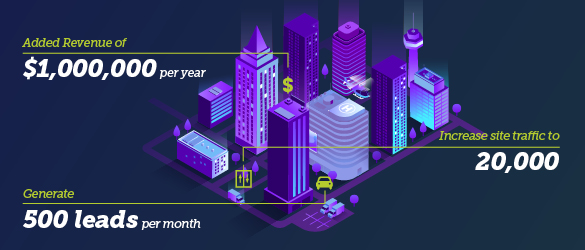
Are we getting it right?
The ability to speak directly to the marketplace and understand what they are interested in and what questions they ask, enables the company to understand whether they need to do anything differently.What’s next?
Marx believes that the awareness and exposure that is being gained is very important, and it’s only the beginning. There’s still much to be done, from increased involvement in Linked In discussion groups to targeted campaigns in specific locations, as well as blogging in other languages such as Spanish and Portuguese.Leveraging the power of marketing automation
The company is just beginning to benefit from the powerful marketing tools available on HubSpot including lead scoring and nurturing. Having tripled the amount of contacts, there is a wealth of potential customers to cultivate, taking them from the awareness and consideration stages through to making the decision to purchase.It takes time, effort and investment
Today, all Bermad’s divisions are involved, with 4-5 people at HQ contributing to content creation as well as support from professionals at the company’s various subsidiaries. Blogs are published on a monthly basis for all four segments (waterworks, irrigation, fire protection and building & construction), supported by email blasts, newsletters and ongoing social media posts. Campaigns are run to support product launches, exhibitions and special events. All marketing activities are integrated into Bermad’s CRM system, allowing the sales team to see a 360° view of potential customers and enabling them to close more deals. “Today, nobody asks why we are doing it,” notes Marx. “We’re just beginning to see the benefits.”How To Grow Your Business Using the Flywheel
By
Ilan Amit
, 23/01/2019
That’s when the real growth happens.
 Simply put, the top of the funnel (TOFU) is where you build awareness about your company and the problem you address, the middle of the funnel (MOFU) is where you teach people how to choose a solution, and the bottom of the funnel (BOFU) is where you explain why your product is the best solution.
The funnel has a major weakness: It doesn’t take into account that the people coming out of the bottom of the funnel can have a major impact on the people going into the top of it — in fact, people at the bottom of the funnel can feed those going into the top of the funnel.
Conversely, the people leaving the bottom of the funnel can prevent other people from entering the top of the funnel.
Simply put, the top of the funnel (TOFU) is where you build awareness about your company and the problem you address, the middle of the funnel (MOFU) is where you teach people how to choose a solution, and the bottom of the funnel (BOFU) is where you explain why your product is the best solution.
The funnel has a major weakness: It doesn’t take into account that the people coming out of the bottom of the funnel can have a major impact on the people going into the top of it — in fact, people at the bottom of the funnel can feed those going into the top of the funnel.
Conversely, the people leaving the bottom of the funnel can prevent other people from entering the top of the funnel.
 The attitude of people when they come out of your funnel has a direct impact on the number of people who are willing to enter the top of the funnel.
The attitude of people when they come out of your funnel has a direct impact on the number of people who are willing to enter the top of the funnel.
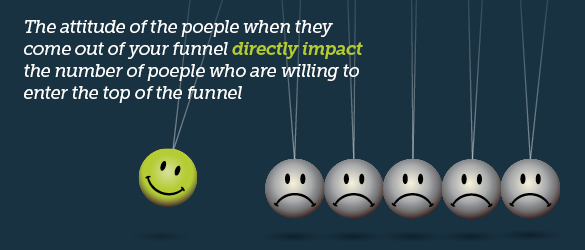
The Flywheel as a Growth Engine for Your Business
Funnels produce leads. What they don’t do is help you close the leads, keep your customers happy, or take advantage of the customers you’ve already acquired to help you grow. That’s where the flywheel comes into play and the inbound marketing methodology helps it spin.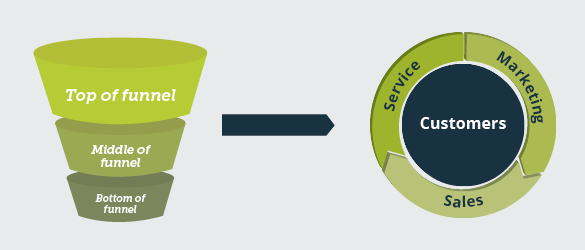
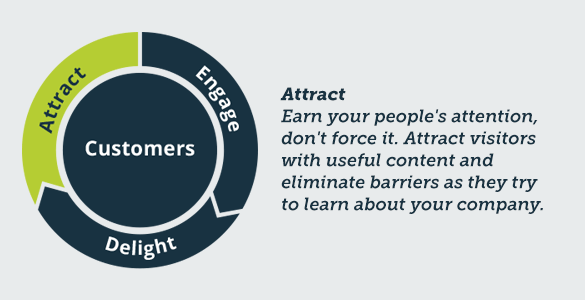 The rotating flywheel represents the growth of your business. Happy customers help fuel your growth. How? By buying from you again, or bringing new customers to you by promoting your product to their extended network of colleagues, friends or family.
“The rotation of the flywheel represents the growth of your business, and happy customers provide the energy that fuels that growth.”
Kyle Jepson, Hubspot Academy
All your marketing activities should be focused on creating customers who will inject good energy into the flywheel and speed up your company’s growth.
The rotating flywheel represents the growth of your business. Happy customers help fuel your growth. How? By buying from you again, or bringing new customers to you by promoting your product to their extended network of colleagues, friends or family.
“The rotation of the flywheel represents the growth of your business, and happy customers provide the energy that fuels that growth.”
Kyle Jepson, Hubspot Academy
All your marketing activities should be focused on creating customers who will inject good energy into the flywheel and speed up your company’s growth.
Combining Funnels and Flywheels
While the flywheel represents your company as a whole, funnel charts can help you improve a particular aspect of your business performance, for example, your sales funnel. Analyzing it can help you understand where you’re losing customers along the way. When your entire company starts thinking about accelerating the flywheel as a whole instead of focusing on improving individual funnel metrics, major strides can be made. That’s when the real growth happens.Rebranding – so much more than just a logo or color palette
By
Miri Peled
, 19/02/2018
Rebranding – so much more than just a logo or color palette. What you'll need to do when rebranding.
Refresh or rebrand?
When rebranding, you can either refresh and improve your current branding or start over and create an entirely new one. No matter what you decide, the rebranding process involves a lot more than designing a new logo or changing your corporate color palette. Here’s what you’ll need to do:- Defining a clear rebranding strategy.
- Reanalyzing your company’s vision, mission and values.
- Conduct market research and competitor research including new players who may have popped up more recently.
- Research existing customers, potential customers and target audiences.
- Redefine your message.
- Create a new visual identity.
- Create new marketing materials.
- Relaunch your brand (internally and externally).



























